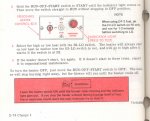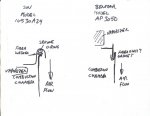- 10,349
- 94
- 48
- Location
- Meadows of Dan, Virginia
Over the last few years, I have spent a lot of time on the fuel burning heater and have come to consider it fairly safe to operate, in particular with diesel fuel.
My 8x8 was never equipped with any other type of heater, so there wasn't much of a decision here.
Any malfunction that I have run into, was easily attributed to old and corroded units and I have been playing with more than 1/2 dozen units made by Stewart Warner and Benmar types.
The military technical manuals rarely explain anything, beyond statements like "replace" or inform next higher level of maintenance and as we all know that can become frustrating at times. Typical instruction for starting the fuel burning heater is shown in the image below.
The point is that fuel can get past the combustion chamber and into the discharge air on a brand new heater too. I posted a note on this some time ago, but decided at the time that the leak was due to corrosion. Not so, an NOS Benmar heater will leak if it doesn't start after the the first few minutes. Only a thin mesh type gasket is used and with age, it will deteriorate.
If the fuel control valve is functioning, but the heater fails to start, it will dump 1/4 cup (60 cc) of fuel into the combustion chamber within 3 minutes and some of this fuel may leak into the fresh air ducting downstream from the heater.
The seal between the combustion chamber and the fresh air, blowing past the heat exchanger is not under a lot of compression and fuel will leak past this joint under the right circumstances in both SW and Benmar units. The Stewart Warner heaters are safer when operating in the vertical position in this respect, leaving all the unburnt fuel in the combustion chamber only, if there is a leak. The gasket here is a silicone o-ring plus a fiber "washer", more substantial than the Benmar gasket.
If gasoline is used for fuel, I'd be seriously concerned about using these heaters if they didn't start right away (within 60 to 90 seconds).
So, if the heater doesn't start according to instructions, you'll have to take it apart and remove any fuel that may be left in it or "notify maintenance" as it were. A possible solution for the Benmar heater is to use a high temperature "stove" cement or similar. The SW gasket is much less likely to be effected by age.
.
My 8x8 was never equipped with any other type of heater, so there wasn't much of a decision here.
Any malfunction that I have run into, was easily attributed to old and corroded units and I have been playing with more than 1/2 dozen units made by Stewart Warner and Benmar types.
The military technical manuals rarely explain anything, beyond statements like "replace" or inform next higher level of maintenance and as we all know that can become frustrating at times. Typical instruction for starting the fuel burning heater is shown in the image below.
The point is that fuel can get past the combustion chamber and into the discharge air on a brand new heater too. I posted a note on this some time ago, but decided at the time that the leak was due to corrosion. Not so, an NOS Benmar heater will leak if it doesn't start after the the first few minutes. Only a thin mesh type gasket is used and with age, it will deteriorate.
If the fuel control valve is functioning, but the heater fails to start, it will dump 1/4 cup (60 cc) of fuel into the combustion chamber within 3 minutes and some of this fuel may leak into the fresh air ducting downstream from the heater.
The seal between the combustion chamber and the fresh air, blowing past the heat exchanger is not under a lot of compression and fuel will leak past this joint under the right circumstances in both SW and Benmar units. The Stewart Warner heaters are safer when operating in the vertical position in this respect, leaving all the unburnt fuel in the combustion chamber only, if there is a leak. The gasket here is a silicone o-ring plus a fiber "washer", more substantial than the Benmar gasket.
If gasoline is used for fuel, I'd be seriously concerned about using these heaters if they didn't start right away (within 60 to 90 seconds).
So, if the heater doesn't start according to instructions, you'll have to take it apart and remove any fuel that may be left in it or "notify maintenance" as it were. A possible solution for the Benmar heater is to use a high temperature "stove" cement or similar. The SW gasket is much less likely to be effected by age.
.
Attachments
-
88.2 KB Views: 125
Last edited:





